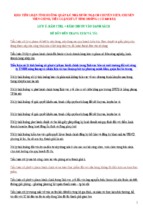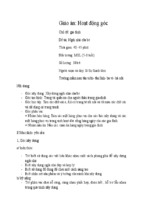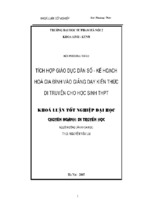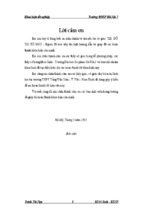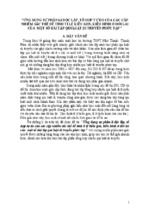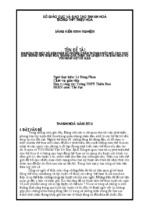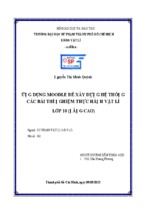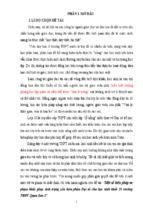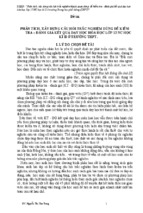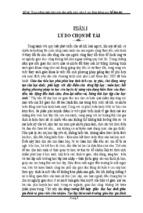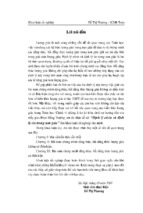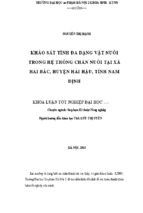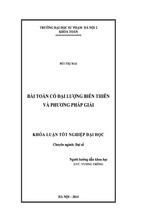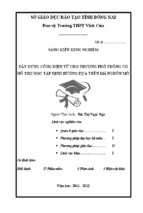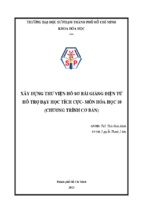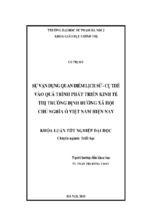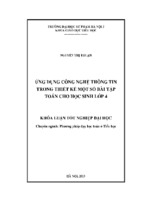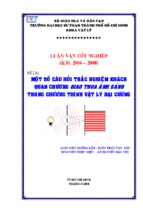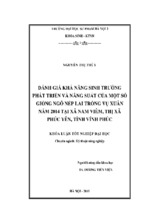1
,
SỞ GIÁO DỤC ĐÀO TẠO TỈNH ĐỒNG NAI
ĐƠN VỊ: TRUNG TÂM GDTX LONG KHÁNH
*******
Mã số………………
(Do HĐKH Sở GDĐT ghi)
SÁNG KIẾN KINH NGHIỆM
HOW TO IMPROVE YOUR USE OF ENGLISH
GRAMMAR
Người thực hiện : Bạch Thị Đào
Lĩnh vực nghiên cứu
- Quản lý giáo dục
- Phương pháp dạy học bộ môn ………
- Lĩnh vực khác ………
Có đính kèm:Các sản phẩm không thể hiện trong bản in SKKN
Mô hình
Phần mềm
Phim ảnh
Hiện vật khác
Năm học 2011-2012
BM02-LLKHSKKN
2
SƠ LƯỢC LÝ LỊCH KHOA HỌC
I. Thông tin chung về cá nhân.
1. Họ và tên: Bạch Thị Đào
2. Ngày, tháng, năm sinh: 17/ 07/ 1967
3. Nam - Nữ: Nữ
4. Địa chỉ: 19 Hoàng Diệu - P. Xuân Thanh - TX. Long Khánh - Đồng Nai
5. Điện thoại: 0613 783 244
Di động: 0918. 819 313
6. Fax:.............................................. Email:.........................................................
7. Chức vụ: Phó giám đốc trung tâm GDTX Long Khánh
8. Đơn vị công tác: Trung tâm giáo dục thường xuyên Long Khánh
II. Trình độ đào tạo.
- Học vị (hoặc trình độ chuyên môn, nghiệp vụ) cao nhất: Cử nhân Anh Văn
- Năm nhận bằng: 1989
- Chuyên nghành đào tạo: Sư phạm tiếng Anh
III. Kinh nghiệm khoa học.
- Lĩnh vực chuyên môn có kinh nghiệm: Quản lý chuyên môn và Giảng dạy
Tiếng Anh.
- Số năm kinh nghiệm: 22 năm
- Các sáng kiến kinh nghiệm đã có trong 5 năm gần đây
- Phương pháp dạy ngữ pháp (Grammar)
- Giáo viên dạy giỏi cấp trường
- Về công tác quản lý: Quản lý chuyên môn
3
Subject: How to improve your use of English grammar
I. Lý do chọn đề tài.
Mỗi thầy cô giáo cũng như mỗi học viên đều có con đường riêng để đến với kiến
thức. Vì thế trong mỗi giáo viên chúng ta làm sao để học viên nắm bắt được kiến
thức, bám sát chuẩn kiến thức - kỹ năng và yêu cầu học tiếng Anh một cách có
hiệu quả. Do đó việc thực hiện đổi mới phương pháp dạy - học ngoại ngữ là một
vấn đề thời sự quan trọng ở đất nước ta trong những năm gần đây và là nhu cầu
thiết thực nhất. Xuất phát từ yêu cầu thực tế đó nên việc dạy học môn Anh văn
cũng được các cấp ngành quan tâm, đặc biệt là những người đang trực tiếp giảng
dạy bộ môn này.
Về góc độ chuyên môn. Subject : How to improve your use of English
grammar. Bản thân muốn đổi mới phương pháp dạy học phát triển về cách dùng
ngữ pháp trong bộ môn này để tạo không khí ngoại ngữ trong tiết học nhằm phát
huy khả năng và xu thế phát triển toàn diện mọi học viên trong nhà trường.
Vì sao phải đổi mới và đổi mới bắt đầu từ đâu quả là câu hỏi không dễ;
Theo tôi câu trả lời phải ở cả hai: giáo viên và học viên. Thứ nhất từ phía học
viên, các em cần được khuyến khích và hình thành ý thức yêu môn học này,
nguyện vọng chính đáng của các em là nắm được kiến thức qua phương pháp học
mà giáo viên hướng dẫn đồng thời đạt được khối lượng kiến thức cơ bản có thể
ứng dụng trong đời thường; Thứ hai là do chính từ phía giáo viên. Với cấu trúc
đổi mới của chương trình gồm bốn kỹ năng: Nghe - nói - đọc - viết cho mỗi đơn
vị bài học (gồm 16 bài), người giáo viên phải đầu tư cách dạy sao cho phù hợp
với từng kỹ năng và cách dạy thế nào để một tiết học ngoại ngữ sinh động, học
viên biết cách dùng các cấu trúc câu sao cho chuẩn, không bị nhàm chán và sai
lệch. Đó là lý do mà bản thân tôi cũng như tất cả các giáo viên dạy ngoại ngữ đều
trăn trở và mong muốn sao cho tiết học ngữ pháp được sinh động hơn và học viên
biêt cách đặt câu cho đúng, để lớp học có không khí ngoại ngữ hơn.
II. Tổ chức thực hiện đề tài.
1. Cơ sở lý luận:
Giáo dục ý thức tự học môn tiếng Anh bằng cách đa dạng hóa các hình
thức, cách thức học và nội dung học. Một trong những kỹ năng quan trọng nhất
trong quá trình giao tiếp bằng ngôn ngữ khác bên cạnh tiếng mẹ đẻ.
Cho học viên thấy được tầm quan trọng của quá trình rèn luyện các kĩ năng
(Skills) trong học tập ngoại ngữ; Bên cạnh đó, phát huy tính năng giao tiếp bằng
ngôn ngữ trong nhiều hoàn cảnh và tình huống đặc thù phong phú. Với mục tiêu
giáo dục phát triển ở TTGDTX là giúp học viên phát triển toàn diện về đạo đức,
4
trí tuệ, phẩm chất, thẩm mỹ và các kỷ năng cơ bản, phát triển tính năng động và
sáng tạo ở mỗi học viên.
Tạo sự hứng thú cho học viên trong giờ học, đồng thời kích thích óc tò mò,
hiếu kì cũng như khả năng sáng tạo của học viên khi tham gia bài học, tiến hành
học các mẫu câu, các loại cấu trúc câu từ đơn giản đến câu phức tạp...“ Chương
trình giáo dục phổ thông ban hành theo Quyết định số 16/2006/QĐ-BGDĐT ngày
5/5/2006 của Bộ trưởng Bộ GDĐT đã nêu: “ Phát huy tính tích cực, tự giác chủ
động sáng tạo của học sinh, phù hợp với đặc trưng môn học, đặc điểm, đối tượng
học sinh, điều kiện của từng lớp học, bồi dưỡng học sinh phương pháp tự học,
khả năng hợp tác, rèn luyện kỹ năng vận dụng kiến thức vào thực tiễn, tác động
đến tình cảm đem lại niềm vui, hứng thú và trách nhiệm học tập cho học sinh”.
2. Nội dung, biện pháp thực hịên các giải pháp của đề tài.
a. Nội dung:
THE CONTENT
I. Introduction :
1.Grammar in general
2. Grammar- an essential component.
3. The aim of grammar practice.
II. How to improve your use of English grammar
III. Types of grammar practice and the ways to deal with them :
1.
2.
3.
4.
5.
6.
7.
type 1 : Awareness
Type 2 : controlled drills
Type 3 : Meaningfull drills
Type 4 : Guided, meaningfull practice
Type 5 : (structure- based) free sentence composition.
Type 6 : ( structure- based) discourse composition.
Type7 : Free discourse
IV. English Grammar Analysis :
V. Conclusion :
Topic : How to improve your use of English grammar
I. Introduction :
5
1. Grammar is general :
Grammar is somtimes defined as the way words are put together to make
correct sentences. This is, as we shall see presently, an over-simplification, but it
is a good starting-point (and an easy way to explain the term to young learners).
Thus is English I am a teacher is grammatical, I a teacher,am I are a teacher are
not.
We can, however, apply the term ‘ grammatical’ to units smaller than
sentences. A brief phrase said or written on its own can be grammatically
acceptable or unacceptable in its own right : a tall woman sounds right ; a woman
tall does not.The same may be true of single words : compare went with goed.
Further, the minimal components to be combined may not be whole
words; for example, the-ed suffix indicating the past tense of a regular verb in
English, or the-s plural of nouns. And somtimes it is not even a question of
putting ‘bits’ before or after other ‘bits’; words may actually change their spelling
and pronunciation in certain grammatical contents : irregular forms of the past
tense, for example, in English...
Therefore, English grammar can be regarded highly in constructing the
correct sentences because people can know if the sentence is right or wrong based
on the fact that it is grammatical or not. Besides, grammar is extremely essential
for four skills of learning English.
2. Grammar- an essential component :
Grammar - seen as an essential component of second and foreign language
proficiency and competence - is presented communicatively, with controlled
accuracy - based activities leading to fluency - based communicative practice. In
this way, there is a link between grammatical form and communicative function.
So we can master the skills of speaking and listening and also based on the
grammatical structures learners can overcome the difficulties in writing and
reading.
3. The aim of grammar practice :
The aim of grammar practice is to learn the structures. So throughly that
we’ll able to produce them correctly on their own. Learners must make the ‘leap’
from form-focused accuracy work to fluent, but acceptable, production, by
6
providing a ‘bridge’ : a variety of practice activities that familiarize them with the
structures in context, giving practice both in form and communicative meaning.
So we must take both form- focused and meaning- focused practice.
II. How to improve your use of English grammar in Teaching :
The best method of improving your use of English is to study the formulas and
sample sentences.Then do the practice exercises at the end of section. After each
group of lesson, there is an exercise using grammatical point you’ve learnt. But
be sure that you can know the type of the exercise so that you can deal with in the
best way.
Exmples :
a) Dangling modifiers : are verbal phrases ( participle, gerund, infinitive)
which do not refer clearly and logically to any word in the sentence.
Ex : a. Taking our seats, our class began.(dangling)
Taking our seats,we began our class.(better)
b. To write well, good books must be read.(dangling)
To write well,we must read good books.
b) Misplaced modifiers : are those which are not placed near the words
modified.
Ex : a. They are just asking for some coffee. (misplaced)
They are asking for just some coffee.(clear)
b. His uncle said that he would come back home on the telephone.
(misplaced)
His uncle said on the telephone that he would come back.(clear)
c) Squinting modifiers : are those that may refer either to a preceding or to a
following word.
Ex : We agreed in the next week to see him.(squinting)
We agreed to see him in the next week.(clear)
In the next week we agreed to see him.(clear)
d) Noun- parallel construction : is a structure whose part of speech is not
parallel.
Ex : a. Walking and to swim are good excercises.(Gerund is not parallel with
infinitive)
Walking and swiming are good excercises.(better)
b. He is not only kind but also knows when to help people (adjective is
not parallel with verb)
He is not kind but also helpful people.(better)
7
e) Careless shift in tense, in mood, in subject or voice, in person, in
number.
Ex : Tense :
The director closed the door and hurries away.
The director closed the door and hurried away.
Ex : Mood :
First rise to your feet then you should make the speech.
First rise to your feet then should make the speech.
Ex : Subject and voice :
Mary likes dancing but singing is also enjoyed by her
Mary likes dancing but she also enjoys singing.
Ex : Person :
- Students will find the school library a great convenience.
You need not leave the school to buy any books.
- Student will find the school library a great convenience.
They need not leave the school to buy any books.
Ex : Number :
One should be thoughtful of their neighbors.
One should be thoughtful of one’s neighbors.
f) Wordiness : is a structure where we use words or phrases that add nothing
to the meaning
Ex : a. ( It was) on September 2nd 1945 (that) Uncle Ho read the Declaration
of Independence.
b. ( The reason why) we missed class (is) because of the rain.
It was... that and the reason why ...is not need.
- On September 2nd1945(that) Uncle Ho read the Declaration of
Independence.
- we missed class because of the rain.
III. Type of grammar practice and the ways to deal with them :
1. Type 1 : Awareness :
After the learners have been introduced to the structure. They are given
opportunities to encounter it within some kind of discourse, and do a task that
focuses their attention on its form and or meaning.
Example : Learner are given extract from newspaper articles and asked to find
and underline all the examples of the past tense that they can find.
8
Learners should pay attention to the structures they are learning so that they can
be aware of what they need to find now. This time they can see and learn with
‘eyes’ and then the structures will be kept firmly in their mind.
2. Type 2 : Controlled drills.
Learners produce examples of the structure : these examples are however,
predetermined by the teacher or texbook, and have to conform to very clear,
closed ended cues.
Example : Write or say statements about John, modeled on the following
example : John drinks tea but he doesn’t drink coffee.
a. Like : ice-cream / cake
b. Speak : English / Italian
c. Enjoy : playing fooball / playing chess
In order to produce the sentences correctly, learners controlled by the
instructors should look at the model frequently. After finishing the
exercise, learners can learn the structure by heart and can use it in
mechanical way.
3. Type 3 : Meaningful drills
Again the responses are very controlled, but lrearners can make a limited choice
of vocabulary.
Choose someone you know very well, and write down their name. Now compose
true statements about them according to the following the model :
He/She like ice-cream ; Or He /She doesn’t like ice-cream.
a. enjoy : playing tennis
b. drink : wine
c. Speak : Polish
Learners need to make sentences by you by using their own vocabulary.
Through composing the statements with the meanings of the words, learners can
improve their translation skill. And more, they must also review the structures
they’ve learnt in order that rhey can make the correct sentences.
4.Type 4 : Guided, meaningful practice.
Learners form sentences of their own according to a set pattern,but exactly
what vocabulary they use is up to them .
9
Example : Practicing conditional clauses, learners are given the cue if I had a
million dollars, and suggest, in speech or writing, what they would do.
So, in this situation, learners become more interested in finding the words and
they should try more to be able to make sentences with their own opinion. They
not only practice the formulas but also understand the usage and the meaning of
the words. To be more effective, learners need to find more situations and
produce their own sentences.
5. Type 5 : (Structure- bases) free sentence composition
Learners are provided with a visual or situation cue, and invited to compose
their own responses ; they are directed to the use the structure.
Example : A picture showing a number of people doing deferent things I shown
to class, they describe it using the appropriate tense.
Learners are free to compose their own responses. To do this well , they
should combine their knowledge of the structures and the ability of observation
and imagination. So their grammar use becomes more natural and freer. After
teacher correct their mistakes, their English grammar will be improved better.
6. Type 6 : ( Structure-based) discourse composition.
Learners hold a discussion or write a passage according to a give task ; they
are directed to use at least some examples of the structure within the discourse.
Example : The class is given a dilemma situation ( ‘you have seen a good friend
cheating in an important test’) and asked to recommend a solution. They are
directed to include modals (might, should, must, can, could, ect...) in their speech
/ writing.
In free activities, learners can discuss or write something, but they still
follow a grammar structure and sentences or examples produced by them must be
directed. Learners should pay attention to the main structures so that they can
give the best product.
7. Type 7 : Free discourse.
As in Type 6, but the learner are given no specific direction to use the
structure, however, the task situation is such that instances of it are likely to
appear.
10
Example : As in Type 6, but know what they want to say, how they say and
which structures they want to use. The important thing is they must use what they
have learnt.
IV. English Grammar Analysis :
Although we have long been a teacher of an English sentence. By « real » we
mean a logical analysis that extends to every word of the sentence. Take, for
example, these four sentences quoted from four different authors, two British and
two American.
a. We drove round the city (round has a noun object, so it’s preposition)
b. Let us not talk rashly of what we do not understand (noun clause, object of
the preposition ‘of’)
c. He earns his living by selling brushes ( gerund as object of a preposition)
d. John was at the library ( prepositional phrase : a preposition and its object).
So far the ‘ relationship’ in (b) and (c) has been intentionally ignored,for to
approach it is another time-consuming task and which proves to be
unnecessary.What is really meant here is the usefulness of the label ‘
object of the preposition’. It seems not to help in any way in telling the
learner about the relatioship. It only complicates the language and makes
the analysis of different kinds of verb impossible. Let us forget altogether
this remote ‘ descendant’ of the Latin language ( I assume it to be Latin
origin for the preposition is inflected with a personal pronoun in the
accusative case - objective).
Now if we accept that, in English, there exist three kinds of verbs :
Intranstive, Transitive and Liking or verbs of Incomplete Predication,
everything will be clearer. The verb, then, becomes the centre of the verb,
all the other part, which one way or another add something to the verb in
the variety of ways and make the English language much liked
internationally. Let’s take the above examples into consideration again. We
can analyses grammatically as follws :
a. We : personal pronoun subject.
drove : intransitive verb, simple past.
b. (We) : personal pronoun subject.
Not talk rashly of : transitive verb, imperative mood.
What we do not understand : noun clause, object of ‘talk of’.
c. He : personal pronoun subject.
Earns : transitive verb, simple present.
His living : gerund used as a noun, object of ‘earns’.
11
By selling brushes : adverbial of manner, answering the question
‘how’ to ‘earn’.
d. John : proper noun subject.
Was : linking verb , simple past.
At the library : preposition phrase : complement of ‘was’.
Or :
John : proper noun subject.
Was (existed) :intransitive verb,simple past.
At the library : adverbial of place,ansering the question ‘ where’ to ‘was’
This analysis : which may seem irrelevant to a native speaker,is of primary
importance to a foreign speaker. Almost every structure that sounds inborn for a
native speaker must be acquired,through analysis, by a foreign speaker. It is
particularly indispensable for him to speak and write English correctly, especially
when his ancestry was neiter Anglo-Saxon nor Greco-Latin.
It is also clear from this analysis that the sense a word assumer in a sentences is
more important than its inflection ( i.e. the change in endings or forms in
accordance with its relationship to other words of the sentence). Thus ‘at the
library’ in (d) should be better considerd as preposition than adverbial, for if we
accept BE to be a linking verb, it is a complement rather than a verb modifier.
V. Conclution :
In the teaching of English grammar, we out through the plethora of terms
andjargon of typical grammar texts to the essential concepts of the language
structure, to those most useful to Vietnamese. Whereas we puzzle at this times
over questions put to us by ours students, wondering why a given explanation
isn’t readily understood, we anticipates the difficulties. We succinctly identify the
particular structural principle to be addressed, list all the possible variation of it,
and give an example in context for each variation. Rarely can examples be found
that are not represented by one of ours examples. We achieve throughtness
without using many words.
Next, students are encouraged to engage with the structures by appropriatly
applying the principles in exercises. The teacher can there by assess the degree to
which students recognize, understand and use the particular structures at hand.
Perhaps more importantly, the exercises generate discular structures at hand.
Perhaps more importantly, the exercises generate discussion and ferret out the
gapsin understanding that might still exist, which can then be filled with further
verbal elaboration in class. Finally, the structures in the lesson by reading
authentic English as it is used by native speakers of English everyday. And it
12
should be a goal of every English learner to acquire the language and be able to
use it as naturally as possible.
Some people say that you do not need to learn grammar in order to learn a
language. This statement is probably true : one learns one’s mother tongue
without studying grammar. But it is, perhaps,a little misleading, and misses the
point. The important question is not considerd as a means of improving mastery
of the language. If learners see the study of grammar as desirable as a part of their
learning, I would think this is surely suffcient justfication to help them by
providing information and grammar practice.
VI. Hiệu quả của đề tài.
Sau khi thực hiện các biện pháp và các giải pháp như đã nêu trên, bản thân
thấy các học viên rất thích học môn ngoại ngữ này. Học viên có tiến bộ trong
cách đăt câu, biết đặt câu hỏi và biết trả lời các câu hỏi một cách mạnh dạn,
không e dè và thích làm các mẫu câu có sữa sai cho các mẫu câu. Biết làm một
bài luận văn đúng với cấu trúc ngữ pháp mà mình vừa được học. Các kỹ năng học
viên đều thực hiện tốt, tạo được điều kiện cho học viên thực hành các kỹ năng
đặc trưng (Listening- speaking – reading - writing) nghe - nói - đọc - viết của bộ
môn này.
Trong năm học qua do áp dụng được phương pháp học làm cách nào để phát
triển kỷ năng về ngữ pháp, cách dùng ngữ pháp cho đúng trong một bài học như
thế đã thu hút đa số học viên thích học và tìm tòi học hỏi thêm về bộ môn này và
đã đăng ký học thêm về các giáo trình có liên quan đến bộ môn, học viên đã
mạnh dạn đăng ký học, luyện thi thêm các văn bằng CCQG A, B, C tiếng Anh.
Số liệu thống kê:
Năm học 2008-2009 vào đầu năm học, lớp 10 có khoảng 40% không thích học
môn ngoại ngữ này và không đọc được bài bằng Tiếng Anh do không biết đặt câu
như thế nào cho đúng. Học viên không quan tâm nhiều về việc học từ vựng, các
câu hỏi, các loại bài text trong sách….
- Đầu năm học 2009-2010 các học viên đã có hứng thú trong việc học Tiếng Anh
và đã đăng ký học luyện thi CCQG A ,B ,C.
Có 60 học viên tham gia dự thi CCQG A
- 30 học viên đăng ký dự thi CCQG B
Cuối năm 2010
- Có 69 học viên đăng ký dự thi CCQG A và đạt 100% có CCQG
Cuối năm 2011. Có hơn 40 học viên tham gia dự thi CCQG A Anh Văn
13
Và 30 học viên dự thi B. Góp phần giải quyết các vấn đề như việc làm tại các
công ty nước ngoài tại địa phương. Nâng cao chất lượng công việc, góp phần giải
quyết những vấn đề thực tiễn, phục vụ công tác giáo dục - đào tạo…
VII . Bài học kinh nghiệm.
Trên đây chỉ là những công việc bình thường của người giáo viên ngoại
ngữ và những hoạt động dạy các học viên phát triển thêm về cách dùng ngữ pháp
cho đúng trong Tiếng Anh. Các hoạt động này, bản thân nghĩ đều nằm trong tầm
tay của giáo viên. Sau một số thử nghiệm, chúng tôi xin rút ra một số kinh
nghiệm sau đây.
* Giáo viên phải nắm kỹ và tuân thủ giáo học pháp đặc thù của bộ môn.
* Sử dụng mẫu mực các hoạt động viết văn, cách dùng các cấu trúc câu cho
đúng ngữ pháp của tiếng Anh, hạn chế tối đa việc sử dụng tiếng mẹ đẻ trên lớp,
giảng dạy theo tiến trình đồng tâm xoáy ốc là chủ yếu không để thời gian trống
lãng phí trên lớp, rèn luyện kỹ năng và thực hành là chủ yếu.
* Tạo mọi điều kiện để học viên được thực hành nghe - nói - đọc - viết
thông qua việc đặc câu cho đúng, học viên sẽ mạnh dạn nói tiếng Anh mà không
sợ sai.
* Giáo viên phải là người nhạy bén, có kiến thức, sâu rộng và vững chắc về
ngoại ngữ mình dạy kèm theo kiến thức phổ thông và chính trị; không được chủ
quản ỷ lại vào bản thân mình, cần chuẩn bị tốt cho học sinh về mặt trận tâm lý
khi giảng dạy - thái độ nhanh, chính xác, tự tin, nhiệt tình.
Tranh thủ sự hỗ trợ của lãnh đạo nhà trường, ý kiến của đồng nghiệp và
giáo viên chủ nhiệm, và gia đình học sinh để tổ chức các hoạt động ngoại khóa và
phụ đạo có hiệu quả cao và suông sẻ.
VIII . Kết luận.
“ How to improve your use of English grammar”.
là cơ sở và là tiền đề cho các hoạt động dạy ngữ pháp và học tiếng nước ngoài ở
các TTGD thường xuyên hiện nay. Giáo viên ngoại ngữ cần cố gắng khắc phục
khó khăn để tạo ra được môi trường học tập tốt nhất có thể cho học viên. Hướng
vào mục đích cuối cùng của việc dạy và học ngoại ngữ là hiểu và biết sử dụng
ngữ pháp đúng để đặt được câu và làm được một bài văn mới bên cạnh tiếng mẹ
đẻ, giáo viên vừa phải tự nâng cao trình độ chuyên môn và trình độ kiến thức phổ
thông, vừa phải rèn luyện phẩm cách và nêu cao đạo đức nghề nghiệp.
Có không khí ngoại ngữ tốt, biết cách đặt câu chuẩn, học viên sẽ tự tin hơn
trong việc sử dụng ngôn ngữ tiếng nước ngoài và một tiết học sẽ gây nên hiệu
14
ứng dây chuyền hiệu quả cho các tiết học khác, kể cả khác bộ môn, gây hưng
phấn cho cả thầy lẫn trò trong suốt quá trình dạy và học ngoại ngữ.
IX. Tài liệu tham khảo.
- Sách giáo khoa chương trình trung học phổ thông của Bộ GDĐT.
- Các tài liệu sách tập huấn sử dụng sách các khối lớp bổ túc.
- Tài liệu bồi dưỡng giáo viên thực hiện chương trình sách giáo khoa các
khối lớp THPT môn tiếng Anh Nhà xuất bản Giáo dục.
- Grammar in use ((L.G.Alexander)
- Các giáo trình có liên quan như:
- Stream line English ( Oxford English)
- “First thing first”- (L.G.Alexander)
- “Inside out” –(Elementary) - Macmillan
- “ Connect 1-2-3” –( JackC.Richards) Cambridge –university press
- Và các giáo trình khác về bộ môn tiếng Anh…
Long Khánh, ngày 20 tháng 4 năm 2012
Người thực hiện
Bạch Thị Đào
15
Đơn vị : TTGDTX
Thị xã Long Khánh
Tỉnh Đồng Nai
CỘNG HÒA XÃ HỘI CHỦ NUHĨA VIỆT NAM
Độc lập – Tự do – Hạnh Phúc
Long Khánh ngày 20 tháng 04 năm 2012
BẢN KHAI THÀNH TÍCH CÁ NHÂN
( Đề nghị công nhận CSTĐ cấp cơ sở năm học 2011-2012 )
SƠ YẾU LÝ LỊCH.
Họ và tên: Bạch Thị Đào. Năm sinh : 17/ 07/1967
Đơn vị công tác: Trung tâm Giáo dục thường xuyên thị xã Long Khánh.
Trình độ văn hoá : 12/ 1 2
Trình độ chuyên môn: Cử nhân ngoại ngữ, Anh văn
Trình độ chính trị: sơ cấp
Chức vụ : Phó giám đốc trung tâm GDTX
THÀNH TÍCH ĐẠT ĐƯỢC TRONG NĂM HỌC.
I. Thực hiện nhiệm vụ chuyên môn, khối lượng, chất lượng:
Trong năm học qua, được sự quan tâm của Ban lãnh đạo trung tâm và sự kết
hợp công tác hài hòa nhiệt tình của bản thân và đồng nghiệp. Tôi đã đạt được
những kết quả như sau:
1. Về công tác giảng dạy, chuyên môn:
Hoàn thành mọi công tác chuyên môn. Đảm bảo 100% ngày giờ lên lớp.
Thực hiện công tác giảng dạy một cách nghiêm túc truyền bá kiến thức đầy đủ,
chính xác, đến từng học viên. Đạt giáo viên dạy giỏi cấp trường. Tham gia mở
các lớp tiếng Anh, luyện thi CCQG tiếng Anh tại trung tâm. Trong năm 20112012 đã mở được các lớp học tiếng Anh tại trung tâm. Trong đó có một lớp luyện
thi CCQG với số lượng 40 học viên đăng ký học tại Trung tâm. Ngoài ra tôi cũng
đã tham gia coi và chấm thi các kỳ thi CCQG tại Sở GDĐT Đồng Nai. Tham gia
chấm thi hội giảng giáo viên giỏi tỉnh năm học 2009 - 2010 tại Sở GDĐT Đồng
Nai.
2. Công tác quản lý chuyên môn:
16
Nắm bắt và theo dõi chuyên môn các lớp chủ nhiệm sâu sắc. Giải quyết hợp
lý mọi trường hợp và quyền hạn của một phó giám đốc đối với đồng nghiệp và
học viên. Đôn đốc và xử lý công việc chuyên môn có hiệu quả tốt.
3. Về công tác Đảng, đoàn thể:
Được đông đảo đồng nghịệp và học viên Trung tâm tín nhiệm. Trong năm
2011-2012 đã thực hiện và triển khai kịp thời các Nghị quyết của cấp trên đề
ra.Thục hiện và phổ biến chuyên môn đến từng thành viên trong Trung tâm một
cách có hiệu quả, thiết thực.. Tổ chức cho các đồng nghiệp hoạt động có hiệu
quả, tạo điều kiện phấn đấu và rèn luyện trong từng thành viên tại trung tâm.
Xung kích trong các phong trào VN, TDTT và nhất là vận động phong trào hiến
máu nhân đạo, trong năm đã vận động 2 đợt, hiến được 75 đơn vị máu. Tham gia
dự các buổi lễ meeting bài trừ tệ nạn ma túy, hút thuốc lá trong trường học. Giúp
các ĐVTN trung tâm tham gia các cuộc thi ATGT, phòng chống ma túy, tham
gia dự thi Bí thư chi đoàn giỏi, trong cụm thi đua trường học, giải nhì đồng đội
trong cuộc thi chạy việt giã…..
* Công tác Đảng: Luôn nỗ lực phấn đấu hoàn thành tốt nhiệm vụ của người
đảng viên, góp phần xây dựng Chi bộ trong sạch vững mạnh, trong năm đã giới
thiệu 2 đoàn viên ưu tú tham gia lớp học Trung kiên tại thị xã để Đảng xem xét
và kết nạp.
Là một đoàn viên Công đoàn tích cực, đạt phụ nữ 2 giỏi và luôn góp phần xây
dựng tổ chức Công đoàn vững mạnh.
II. Cải tiến, giải pháp hữu ích, sáng kiến.
- Đảm bảo sinh hoạt chuyên môn và dự giờ đồng nghiệp.
- Sáng kiến kinh nghiệm: Dạy và học đạt hiệu quả cao qua đầu tư dạy
Grammar. “HOW TO IMPROVE YOUR USE OF ENGLISH GRAMMAR”.
III. Học tập bồi dưỡng, chuyên môn nghiệp vụ.
- Tham gia 100% chương trình bồi dưỡng nâng cao trình độ do Sở GDĐT
Đồng Nai tổ chức.
- Bản thân đang theo học lớp thạc sỹ quản lý – Master in Management. (MM)
khóa 2011-2013
- Luôn phối kết hợp với lãnh đạo trung tâm để nâng cao hiệu quả quản lý về
chuyên môn.
17
IV. Tham gia xây dựng tập thể.
- Có tinh thần ý thức tập thể cao, luôn biết tự sửa sai và luôn quan tâm giúp
đỡ đồng nghiệp trong Trung tâm.
- Được bầu chọn CSTĐ cấp cơ sở.
Trên đây là bản khai thành tích cá nhân mà trong thời gian qua bản thân đã
đạt được.
Thủ trưởng cơ quan
(Ký tên đóng dấu)
Chủ tịch công đoàn
Người khai
Bạch Thị Đào
- Xem thêm -

